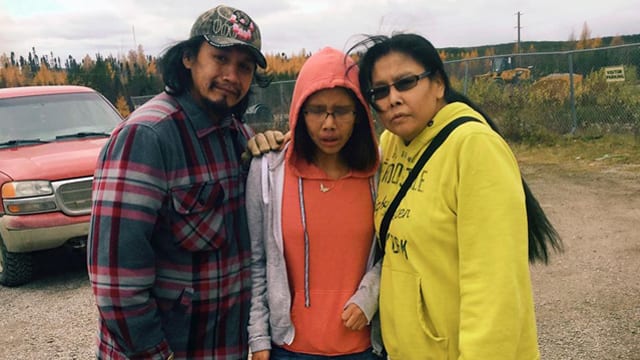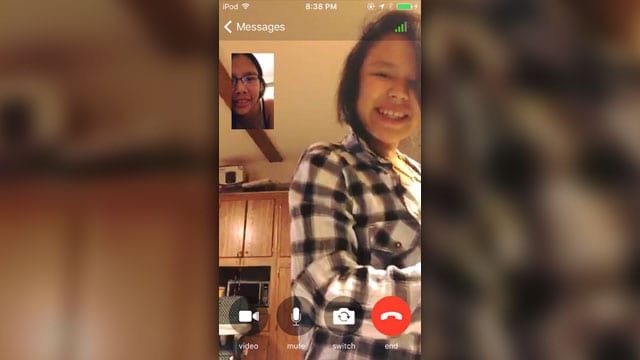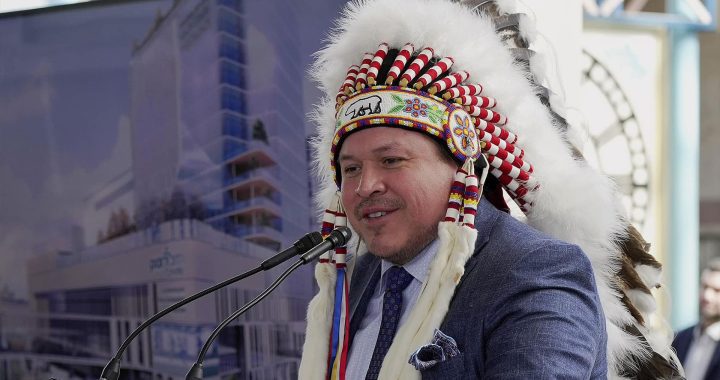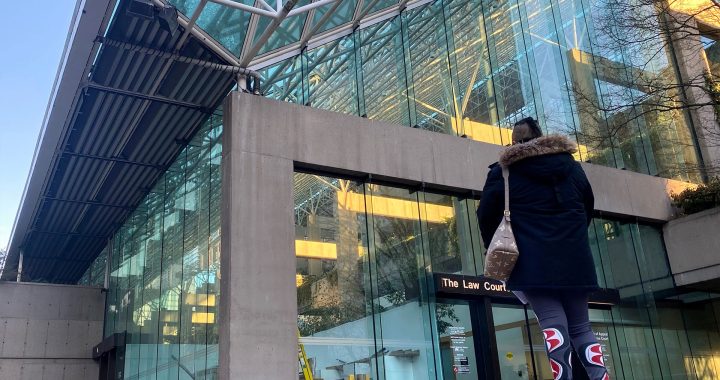

(Kanina Sue Turtle, middle, with father Clarence Suggashie and mother Barbara Suggashie visiting Poplar Hill First Nation for a funeral Oct. 18, 2016. She died by suicide Oct. 29, 2016. Photo provided by family.)
The family of Kanina Sue Turtle has been waiting almost two years for answers into her suicide and feel a report released Tuesday into the death didn’t change that.
“It just pissed me off,” said Barbara Suggashie, Kanina’s mother from her home in Poplar Hill First Nation near the Ontario and Manitoba border.
“I can’t get answers from anyone.”
Kanina was one of eight Indigenous children that died within a three-year span that were part of a so-called expert panel review that spent the last year digging into the deaths looking for systemic issues that may have been a factor.
Six were from Nishnawbe Aski Nation in northwestern Ontario.
The report was released publicly Tuesday but sent to families over the weekend.
It also looked at four non-Indigenous deaths and found the system failed all 12 of the children.
Kanina died by suicide Oct. 29, 2016 in a Sioux Lookout foster home owned and operated by Tikinagan Child and Family Services. The 15-year-old filmed her death and the panel reported it was with her iPad, but it was an iPod.
The video, which was first reported by APTN News in February, shows Kanina was left alone in a back room of the home for 45 minutes before a worker came to check on her. By then it was too late.
Police wanted to obtain video of teen’s suicide but coroner wouldn’t pay: OPP documents
The panel’s report doesn’t mention she was left alone for that length of time or why even though it had that information.
Suggashie said she has never been told why Kanina was left alone the day she died. She had hoped the panel’s report would tell her what happened.
The panel did highlight Kanina’s deteriorating state.
“In the four months prior to her death she was placed in an Indigenous youth healing centre. She was medically evacuated out twice in response to self-harming behaviour and suicide attempts. The most recent visit to hospital occurred five days prior to her death,” the panel found.
Kanina had been in and out of child protective services for most of her life as her parents struggled with alcoholism.
“She was happy here. She wasn’t suicidal at home. She just wanted to come home,” said Suggashie.
While the report found the system failed the children it said no one person in child protective services or child welfare agency was responsible for the any of the deaths.
“It’s bullshit,” said Jeffery Owen, father of Amy Owen, 13, who died by suicide in an Ottawa group home April 17, 2017. “I think they are just covering up for each other. It’s really frustrating not getting answers and not doing anything about it.”
Amy, who was also from Poplar Hill, had multiple visits to the Children’s Hospital of Eastern Ontario in the months before she died.
“Amy was seen in urgent care and the emergency department of the local hospital on multiple occasions in the six months leading up to her death. Amy was admitted to hospital on two occasions, the last being for four days, approximately two weeks before her death. From her discharge to the day of her death, she was brought to the emergency department on three additional occasions related to self-harm and suicide ideation or attempt,” the report states which is drawn largely from the coroner’s report into her death.
The coroner’s report on her death said she was supposed to be transferred to a home that could have her under 24-hour supervision but there was no space at the time. The panel’s report doesn’t mention this.
“On the day of Amy’s death at the age of 13, staff at the residential program checked on her regularly as she was in her bedroom alone. Twenty minutes after the previous check, staff returned to her room with a snack for her and found her hanging by the cord from the window blind. Resuscitation attempts were unsuccessful,” the report states.

(Amy Owen.)
As APTN previously reported, Kanina was close to another child under the authority of Tikinagan, Jolynn Winter.
Jolynn’s death was also reviewed by the panel.
The panel reported both were caught kissing and a Tikinagan worker told Kanina she could be charged with a crime as Jolynn was just 12 at the time. This was two days before Kanina died.
APTN has the document where this interaction was recorded. The panel didn’t include in their report that Tikinagan suspected both were suicidal at the time according to a report of the incident by Kanina’s counsellor.
They were then separated in different homes in Sioux Lookout. In Kanina’s home the Wifi was shut off.
Kanina ran away the day before she died and the Ontario Provincial Police found her and returned her back to the home. She attempted to take her life that day and recorded it as well.
The next day she hung herself.
Jolynn died in Wapekeka First Nation in January 2017.
“At the age of 12, Jolynn died by suicide in her father’s home. Kanina’s death by suicide is felt to have been an influencing factor in Jolynn’s suicide. The autopsy indicated significant evidence of self-harm on various parts of Jolynn’s body,” the panel stated.
The panel confirmed Amy was in a suicide pact with two other youth who had already died but didn’t say who it was.
APTN previously reported those girls were Kanina and Jolynn.

(Kanina Turtle, in the small screen, with Jolynn on Facetime a couple days before Turtle’s death.)
The report’s overall theme was that the deaths of the 12 children were the result of systems failing repeatedly to meet their fundamental needs.
The children died between January 2014 and July 2017 and while in residential care or placement of a children’s aid society or an Indigenous child welfare agency.
“While no one individual or organization is at fault for these failures, it is important to recognize that it is people that make organizations and systems work – and people that define how they must work,” the report said.
Five of the deaths occurred within the first six months of 2017. The chief coroner came up with the seven-member panel, all of whom have expertise in areas of mental health, service systems, residential placements and government administration, not long afterwards.
Starting at the beginning of the year, the expert panel met with nine of the 12 families and visited four First Nations affected by the deaths.
The panel discovered many of the young people had substantial child protection involvement for most of their lives. They all had mental health challenges and histories of self-harming behaviours and or suicidality.
Yet, they were continually silenced said the panel.
“The young people had minimal opportunity to have a voice in their care and their attempts to communicate their needs were often overlooked, ignored and characterized as “attention-seeking.””
Safe spaces on-reserve for at-risk children and youth and a lack of cultural connection to elders and cultural teachings after being placed outside of their communities were among some of the challenges the panel reported.
“In particular, Indigenous child wellbeing societies that serve people in remote First Nations communities have distinct constraints to delivering services that other societies do not; for example, large geographic areas,”the report said.
The panel also found that the young people experienced an average of 12 different placements while in care of children’s aid and Indigenous child welfare agencies.
“Placement selection appeared to be based on what was known to be available, rather than on goodness-of-fit or the young person’s needs,” the panel stated.
The report finds that some of those placements were as far as 1,600 km away from the young people’s home communities.
“The quality of care was impacted by the capacity, lack of supervision, qualifications, training, and education of staff and caregivers,” the report says about the placements that were reviewed.
In some cases, the report said the panel couldn’t determine who was providing services and what type.
Problematic for ensuring appropriate provincial oversight of the children’s aid and Indigenous child welfare agencies responsible for the protection of young people, the panel says.
“It was likely that the ministry was equally unable to understand the pathways through the various systems, both at the individual level and in aggregate,” the report says.
The report delivered a total of five recommendations.
The first one calls on the Ontario and federal governments to “immediately provide equitable, culturally and spiritually safe and relevant services to Indigenous young people, families and communities in Ontario.”
The other recommendations are directed to the provincial ministries of children, education, health and Indigenous affairs to:
*Identify and provide a set of core services and support an integrated system of care for young people and their families across a wholistic continuum to every child in Ontario. Services must include health, mental health and wellbeing, education, recreation, child care, children’s mental health, early intervention services, prevention services and developmental services. Service provision should be geared to the needs and intensity of needs, of each young person and family.
*Develop a wholistic approach to the identification of, service planning for and service provision to high-risk young people (with or without child welfare involvement) that supports continuity of care to age 21 years.
*Strengthen accountability and opportunities for continuous improvement of the systems of care through measurement, evaluation and public reporting.
Alvin Fiddler, grand chief of NAN, is calling on the government to put together a committee to ensure that the recommendations are followed.
“This report shows the urgent need for change in the care of at-risk youth,” said Fiddler in a statement.
“We will propose that the federal and provincial governments task a committee with the implementation of these recommendations so that these tragedies are not repeated,” he said.
-with files from Willow Fiddler










